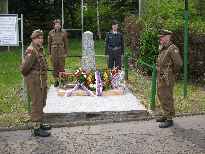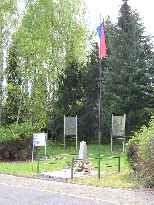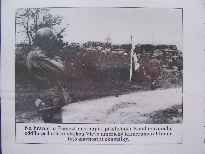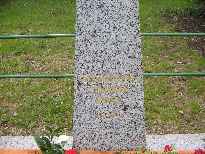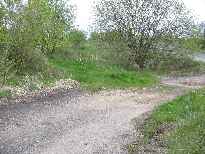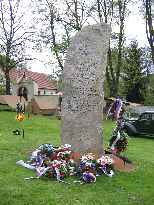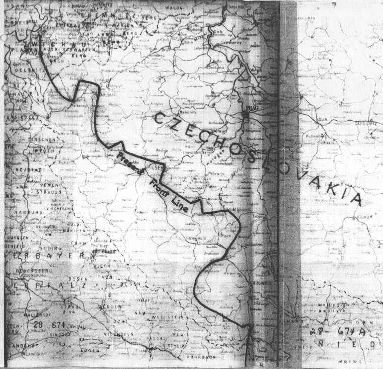| CAST | Czech And Slovak Things | http://www.geocities.ws/czechandslovakthings/ |
|||||||||||||||||||||||||||||
| WORLD WAR 2 | |||||||||||||||||||||||||||||||
1. The CIABG, 22 LHQ and Dunkirk The Czechoslovak Independent Armoured Brigade Group (CIABG) was formed on 1st September 1943 from the original Czechoslovak Brigade with a strength of 194 Officers (with another 207 un-posted Officers surplus to requirements) and 2,365 Other Ranks, plus the men of a newly arrived transport of Czechoslovaks who had been serving in the Middle East and North Africa (including the siege of Tobruk), consisting of 48 Officers and 1,274 Other Ranks. The average strength of the new CIABG in September 1943 was 245 Officers, 129 unposted Officers, and 3,659 Other Ranks. They re-equipped and trained extensively in Britain before being sent to mainland Europe at the end of August 1944. After waiting for more than a month just to the north-east of Falaise they were then not used on the main front, but instead took over the siege of the isolated German garrison in Dunkirk from October 1944 as part of Montgomery's 21 Army Group. No.22 Liaison (Czech) HQ, also known as just 22 LHQ or 22LHQ, was formed in August 1940 at Cholmondeley Camp, the reception centre for Czechoslovak soldiers evacuated to Britain with the fall of France. Its job was to ease relations between the new Czechoslovak Brigade being formed and the British higher command and other units. It remained embedded with the Brigade HQ throughout the war, up to and including its transfer to Czechoslovakia in May 1945. With the end of the war quickly approaching in the spring of 1945, Czechoslovak politicians and senior Officers were very keen for the CIABG to be released from their duties at Dunkirk to take part in the fighting in Germany before their return to their homeland, and many representations were made through various channels to try and achieve this aim. On 4th April 1945 the AA&QMG, LAC, HQ 21 Army Group visited 22 LHQ near Dunkirk and lunched there. In the afternoon he had a brief meeting with the GOC CIABG (General Officer Commanding - General Liška). The object of the visit was to explain that everything possible had been done to obtain the CIABG's release from Dunkirk, but that operational requirements did not make it feasible at that time. While the GOC CIABG appreciated this, he left the AA&QMG in no doubt as to the contingent's eagerness to get on the move towards their own country and to have the opportunity of participating in the war inside Germany. The 'operational requirements' referred to involved the concerns of the British about finding troops to replace the CIABG at Dunkirk, along with American concerns about supply and maintenance of units with British equipment while attached to American forces. 2. A meeting at 21 Army Group Main HQ In the morning of 18th April 1944 American troops crossed the line of the pre-war border from Germany into Czechoslovakia, taking the village of Hranice north of Aš. At 11.30hrs on the 19th there was a telephone call from 21 Army Group to 22 LHQ with an urgent requirement for the CO (Commanding Officer - Colonel H. Bleecker) to fly immediately to the main 21 Army Group HQ. At that moment the CO was visiting various units with the GOC Dunkirk Force (General Liška), so there was a short delay in reaching him and in his returning to his HQ. Meanwhile, arrangements were made for him to fly by Mosquito aircraft from the Coxyde airfield to Eindhoven, and then onwards by Auster. He left at 14.00hrs and returned from his trip the next day at 18.45hrs. Although there were a number of minor things mentioned during the CO's meetings spread over the two days, the first and principle matter under discussion with the BGS (Ops) was the suggestion by the Supreme Allied Commander that a token force be sent from the CIABG to join American forces on their entry into Czechoslovakia. The first question was the size of the force. Although it was originally suggested it be of regimental strength, after discussions which showed the difficulty in obtaining the required number of tank transporters it was considered more appropriate that the Motor Battalion be released. Colonel Bleecker was asked to consider the matter overnight and report the next morning as to the effect of the release on the Brigade, what troops might be needed as replacements, and the composition of the token force. He was also advised that the matter should be kept completely secret and not be mentioned to anyone. Having considered it carefully, the next morning he reported to BGS (Ops) that he had the following two observations to make. First, that although he was not supposed to be interested in political affairs, he had heard several times from senior Czechoslovak officers that it was considered imperative from the political point of view that the entire Brigade be released from Dunkirk and take part in the main fighting in Germany before its return to Czechoslovakia. Second, that the Brigade as a whole should return to Czechoslovakia as soon as possible after the end of hostilities. Both these points were considered necessary to balance the prevailing Russian influence with British trained and equipped Czechoslovak forces. Under those circumstances the reason for sending the token force was not clear to him. In answer to this, Colonel Bleecker was told that it was the wish of the Supreme Allied Commander and that he was only required to agree the composition of the force, now limited to 150 men. In return, Bleecker suggested that this was a matter for the GOC CIABG to decide, but that sending part of the armour and part of the Motorised Infantry might be considered. The matter was then referred to SHAEF (Supreme Headquarters Allied Expeditionary Force) and any further discussions with Bleecker were to take place by telephone. He then returned to 22 LHQ near Dunkirk. At 09.00hrs on 21st April 1945, the day after Bleecker's return, Main HQ 21 Army Group telephoned him and requested that the GOC CIABG be informed, and that the token force under discussion should be ready to leave as soon as possible. The date of departure was to be 24th April. When told of what was proposed, the GOC also did not understand why this force was being sent. However he agreed to provide one, but not as Bleecker had suggested to 21 Army Group the day before. He did not want his units to be split, so therefore suggested that the force should be made up of the entire Light Anti-Aircraft Troop (LAA Tp) consisting of 3 Officers and 81 Other Ranks. Additions to this were suggested, probably to consist of one platoon of the Motor Battalion, one scout section, service units, and extra motor transport for the required petrol and rations. It was also decided that a more senior officer than the commander of the LAA Tp should be in charge of the force, and Lt.Colonel Alois Sítek, commander of the Anti-Tank Battery, was nominated. Instructions required 22 LHQ to send one officer with the force, and this was to be the staff captain, Capt. Geoffrey H. Stephenson, along with his car and batman-driver. CLICK
BELOW TO VIEW BLEECKER'S REPORT ON THE MEETING AT 21 ARMY GROUP AND
TELEPHONE DISCUSSIONS On 22nd April at 10.15hrs a message was sent from HQ 21 Army Group, received by 22 LHQ at 13.55hrs, officially confirming the order for the movement of the Token Force.
Shortly after receipt of the movement order from HQ 21 Army Group, a message was sent at 14.57hrs 22nd April by 22 LHQ as requested giving the final composition of the Token Force.
As can be seen, the British numbers specifically include the staff captain of 22 LHQ (Captain Stephenson) and presumably his batman-driver and their vehicle as previously stated. They are not mentioned in the count and listing of individuals from Czechoslovak sources, but their numbers of 8 Officers and 131 Other Ranks with 7 Motorcycles and 26 vehicles, once the British element is added, equate to the same total. In fact Stephenson, his driver-batman, and their vehicle are never mentioned in any Czechoslovak source. CLICK HERE TO SEE FULL LISTING OF TOKEN FORCE PERSONNEL CLICK HERE TO SEE FULL LISTING OF TOKEN FORCE VEHICLES 5. Departure and journey across Germany On 23rd April the different elements of the Token Force gathered in the village of Bollezeele, about 10 miles south of Dunkirk and 6 miles west of Wormhout (where the Brigade HQ and 22 LHQ were based). They prepared for their journey and arrangements were made for the soldiers to exchange money. At 11.00hrs the OC Token Force (Lt.Col. Sítek) visited 22 LHQ, and at 15.00hrs Col. Bleecker and Capt. Stephenson went with the GOC and C of S (Chief of Staff) of the CIABG to inspect the Token Force and to hear the GOC's farewell. This final day before departure had not been without difficulty. A probable route to the borders of Czechoslovakia had been 'extracted' from Q (M) 21 Army Group, but the combined efforts of 'G' and 'Q' at 22 LHQ had failed to make satisfactory arrangements for the well being of the Token Force in other respects - even in the matter of replenishment points en-route. In the end the CO telephoned BGS Q(AE) HQ 21 Army Group, who promised to make all necessary arrangements. At 06.30hrs on 24th April Capt. Stephenson left 22 LHQ to join the Token Force which was starting for Czechoslovakia at 07.00hrs. There is a brief mention War Diaries of the HQ CIABG which reads as follows.
Each night of the journey billets had to be found in the towns or villages being passed through. Usually there was a barracks in the German towns that served the purpose well, but there were some problems during the journey too. Bridges were down and long and difficult detours had to be made. It was found necessary to do a reconnaissance for each days journey, even with such a small column, and the route was particularly difficult between Trier and Aschaffenburg. Petrol was also a problem. Although it existed, it was difficult to locate as the Americans were moving all the time and nobody knew where anything was to be found. The same applied to Workshop and Recovery facilities, with the added complication that they had no spares for British vehicles. The surfaces and conditions were so bad that after his experience with his own Light Utility vehicle, Stephenson later recommended that any Utility vehicles with the Brigade be exchanged for Jeeps when the time came for the main body to make the same journey. However, it wasn't all bad news. The weather was mainly fine all the way, and except for one motorcycle written off in an accident on the 28th April, all the other vehicles that set out from Dunkirk reached Czechoslovakia. In a letter to 22 LHQ Stephenson remarked on this and comments that "even the carrier" had made the trip successfully, asking one of the other Officers at 22 LHQ to "please pay up". It seems there was a bet on it! CLICK HERE TO SEE GOOGLE MAP FOR JOURNEY OF TOKEN FORCE 24th April: BOLLEZEELE - CASSEL - ARMENTIERES - LILLE - TOURNAI - fork at GAURAIN-RAMECROIS - BASECLES - MONS - BINCHE - CHARLROI - NAMUR - BASTOGNE (farm 10km to NW) A very good run, with a stop for lunch between Mons and Binche, but thought of as rather too far. The distances for following days were therefore less. Stopped at 21:00hrs at a semi-ruined farmhouse about 10km to the NW of Bastogne. Problems with 2 of the tractors towing the guns, both with electrical trouble, one stopping about 40km short of the end of the day, the other about 10km short. One was repaired on the roadside by a mechanic, the other was towed and finally arrived at the farmhouse at 02:00hrs. The 3-ton lorry carrying the petrol "ran a bearing", apparently while attempting to tow the problem tractor, and had itself to be towed by another 3-ton lorry. In fact it was not possible to repair with the resources available and it had to be towed all the way to Czechoslovakia, more than 500 miles. 25th April: BASTOGNE (farm 10km to NW) - BASTOGNE - ARLON - LUXEMBOURG - IGEL - TRIER - HERZERATH Reveille at 06:00hrs. Convoy left at 09:00hrs, minus 1 tractor which left an hour later after being repaired on the spot. The border between Belgium and Luxembourg was crossed at 13:00hrs, and the border between Luxembourg and Germany at 16:10hrs by pontoon bridge. Immediately after the bridge the convoy passed through the first German town, Igel, which was in ruins due to allied bombing. The inhabitants of the village in which the convoy was accommodated did not want to believe that this armed unit was made up of Czechoslovaks. A General Moses was contacted at Wiesbaden and they were told to get in touch with the U.S. 3rd Army at Erlangen. 26th April: HERZERATH - WITTLICH - BERNKASTEL-KUES - KIRCHBERG - SIMMERN - STROMBERG - BINGEN - MAINZ - GROSS-GERAU - DARMSTADT - DIEBURG - ASCHAFFENBURG - BESSENBACH Left Herzerath at 07:47hrs, at Bernkastel-Kues crossed the Moselle River, again by pontoon bridge due to all the normal bridges having been destroyed. At Bingen the convoy came to the River Rhine, stopped for lunch between Bingen and Mainz, then at Mainz crossed over the river. The convoy spent the night at Bessenbach, about 10km east of Ashaffenburg, with the parking place in a meadow and accommodation in a school and vicarage. 27th April: BESSENBACH - MARKTHEIDENFELD - WURZBURG - KITZINGEN - BAMBERG After refilling with fuel and completing the necessary vehicle maintenance the column moved off at 10:00hrs. After a morning stop one of the 3-ton lorries remained standing with a broken radiator, caused by a collision with the vehicle standing in front. At Wurzburg they experienced roads full of heavy American vehicles and tanks. Here they crossed the River Main for a second time, and in Kitzingen for a third, having to make a detour to use the bridge here because the one at Schwarzach to the east of Dettelbach was out of use. The U.S. Third Army at Erlangen was contacted and the Token Force sent on and attached to 97th Infantry Division based at Wunsiedel. A short message sent back to 22 LHQ at 13.52hrs (received there at 06:15hrs on the 28th) gave news of their progress.
At Bamberg the unit met a group of around 200 Czechoslovaks who had been sent to Germany during the war, either as forced labour or to concentration camps as political prisoners, and had now been liberated by the allies. The unit invited them to join them for the evening, and heard from them about the actions of the SS and SA suffered by the Czechoslovak people. 28th April: BAMBERG - SCHESSLITZ - HOLLFELD - BAYREUTH - BERNECK - GEFREES - WEISSENSTADT - WUNSIEDEL - SICHERSREUTH The weather, which had so far been fine, was now worse, raining and cold. The column departed at 10:00hrs, and at the airport in Bayreuth they refilled with petrol. At 17:00hrs the unit arrived in Sichersreuth where they had accommodation, about 3km to the SE of Wunsiedel and only about 15km from the Czechoslovak border. On 29th April the 97th Infantry Division moved out from Wunsiedel and was replaced by the 1st Infantry Division, 1st US Army, to which the Token Force was then transferred. The unit spent the day cleaning and doing maintenance. The following day they completed the maintenance work and prepared for further movement. 6. Crossing the Czechoslovak border and Cheb 1st May : SICHERSREUTH - WUNSIEDEL - THIERSHEIM - SCHIRNDING - CZECHOSLOVAK BORDER - POMEZI (MUHLBACH) - CHEB Reveille at 06:00hrs, breakfast at 07:00hrs, convoy assembled at 08:45hrs. Stephenson had arranged for a number of Press Photographers, Reporters and Public Relations Officers to join them and record the Czechoslovak Army crossing the border of Czechoslovakia, including cameramen of the U.S. 3rd Army, and they now arrived. At 08:55hrs the convoy commander, škpt. Pujman, reported to the unit commander, pplk. Sítek, that the convoy was ready to depart, and at 09:00hrs it moved off. The column crossed the border between 10:00hrs and 11.00hrs and stopped for a brief ceremony. A flagpole was raised, an honour guard formed behind it, and the rest of the men gathered in a semi-circle. The Czechoslovak flag was hoisted by the oldest member of the LAA Troop, rt. Květ, Lt Col. Sítek made a speech, and the national anthem was sung. The unit then continued and entered Cheb at 12:00hrs. Stephenson had also arranged for the Public Relations personnel to be present when they entered Cheb (Eger), making a "triumphant" spectacle. Copies of Lt.Col. Sítek's speech were distributed to the press in both Czech and English, and sound recordings were also made in both languages. Promises were made that they would be played on the Czechoslovak and American networks, and to include news from Czechoslovakia itself and about the Czechoslovak troops from the west. It seems that Stephenson and pplk. Sítek had also put in a considerable amount of "selling talk" with all levels from Patton's Chief of Staff downwards at all the HQs they had visited (U.S. 12th Army, 3rd Army, 97th Division, and 1st Division) to try and get the main body of the CIABG released from Dunkirk and sent to Czechoslovakia. Stephenson described Cheb as being "not much of a place and is 100% German and pretty hostile ones at that". While there the unit was attached to the 18th Infantry Regiment of the 1st US Division. Immediately after their arrival, on the afternoon of 1st May, the unit sent out patrols into the streets of the town, and during the next few days the men of the Token force took over responsibility for security in the town. Patrols were made by the half-tracks and carriers of the unit out to the surrounding villages, but without any serious fighting. They had their hands full not just with taking prisoner the small detachments of German forces throughout the area, but also with the thousands of released and escaped allied nationals who had been prisoners of the Germans. There were at least 5,000 Russians in the town, with almost the same number of Poles plus many French, Belgians, Dutch, Hungarians, and other nationalities. There did not seem to be any definite policy in the American Military Government area, their Military Government teams being very few. It was feared that there would be nobody left to continue this work once the frontline divisions had moved on, so teams were created with a view to keeping this area of the Sudetenland functioning as part of Czechoslovakia and maintaining order and discipline in the rear areas. In view of the hostile local population this could only be done by administrators supported by armed bodies of local Czechoslovaks, and this was proceeded with as quickly as possible. Stephenson obtained permission from the U.S. Military Governor at 1st Division to collect and enlist various groups of Czechoslovaks who had been located in German border towns, bringing them to Cheb, As they arrived they were grouped under an officer and used to assist in the local administration and maintenance of law and order. Originally armed with captured German rifles from various sources, Stephenson then located a German arsenal in the town of Hof and obtained permission from the Americans to draw all the rifles required. As the American advance in front of Cheb seemed to have come to a halt, on 6th May Stephenson and Sítek went to the HQ of 1st US Division to ask that the Token Force be transferred to the spearhead most likely to reach Prague first. They were ordered to report to 2nd US Infantry Division in Plzeň the next day, and arrangements were made to leave in the morning. Por. Sommr with prap. Petrovič and voj. Goetz were sent on to Plzeň by Jeep on orders from 1st US Division to act as liaison between the U.S. Army and the local National Council there. Sections that had been stationed at Františkovy Lázňe and other outlying points were called in and replaced with the recently recruited local Czechoslovaks. However, des.asp. Ungar remained in Františkovy Lázně as liaison with the American army. 7th May: CHEB - MITTERTEICH - TIRSCHENREUTH - NEUSTADT - WEIDEN - WERNBERG - VOHENSTRAUSS - WAIDHAUS - STRIBRO - PLZEN In the morning of the 7th May, Stephenson and Sítek went on ahead of the main column and found the HQ of 2nd US Division in Plzeň, the day after it was liberated. They immediately requested permission to proceed to Prague, but this was refused. The road was still occupied by the enemy in too much strength for them to proceed alone, although the HQ promised to try and obtain permission as soon as it was clear. The two Officers then went to see the 'Burgomaster' and Czechoslovak Military Commander of the town to arrange the official entry of the Token Force into the city. The welcome from these officials was warm, but all were extremely worried about news coming in of heavy street fighting in Prague. The main column of the Token Force left Cheb at 09:00hrs, taking a route back into Germany before returning to Czechoslovakia because the direct road between Cheb and Plzeň was still not totally secure. They entered Plzeň at around 17.00hrs and were welcomed by an enormous crowd, excited at seeing Czechoslovak troops after such a long time. There were bands, processions and girls in national costumes all the way along the route around the city, the first 'real' Czechoslovak town the troops had arrived at. The troops were billeted for the night in the outskirts of the town.
Late in the evening Stephenson went with Sítek to the house of the 'Burgomaster'. From here Sítek telephoned to the GOC in Prague who requested immediate assistance, saying that the situation was critical and the SS were using civilians to screen their tanks and to remove barricades. After discussions with the Czechoslovak Military Commander they went to the HQ of 2nd US Division, informing the Chief of Staff about the situation in the capital and stressing the need for immediate assistance to be sent. They explained that as well as the men of the Token Force there were 1,000 armed 'partisans' with their own transport, waiting at that moment in the main square ready to leave. They asked to be released immediately and be permitted to proceed to Prague. They already had an Officer who had come out from Prague and knew a clear route into the city. The Chief of Staff saw the commanding Officer of 2nd Division, General Richardson [should be General Robertson?] on their behalf and returned with a refusal. The General had said that he agreed with their desire to assist in Prague and would have gone himself with his own men if he had not had direct orders not to. He had been ordered to hold his present line and not to take any offensive action beyond it. He considered that to permit a body of armed men to go beyond this line would be breaking those orders and therefore he could not give his consent. However, a message was sent to US V.Corps (although they were not able to be contacted by telephone) asking for permission to go to Prague. The next day, 8th May, the Token Force moved to the village of Kyšice, just outside Plzeň on the road to Prague. Reports of heavy fighting continued to come in from Prague, and the local population could not understand why the troops did not go to the assistance of the people there. Stephenson was busy back at 2nd Division HQ in Plzeň, but they were unable to release the unit as they had still not received a reply to their request from V.Corps HQ, who were expected to arrive in Plzeň later that day and finally did so at 18.00hrs. Having immediately explained the situation to them, the G3 (Operations) Officer of V.Corps telephoned their Army command, who in turn telephoned SHAEF. The order came back to remain where they were. On May 9th they were still trying to get permission to proceed at V.Corps HQ and were assured that representations had been made through Army command on their behalf, but that nothing could be done until a reply was received. It was suggested that things might be held up until after the armistice period. In the evening Stephenson met some journalists he had previously had contact with. They had just returned from Prague and confirmed that the Russians had entered the city. As a result of the uprising and the fighting that followed, the damage to buildings had been light but civilian casualties quite heavy. Lt.Col. Sítek became increasingly impatient with the continuing delay. On May 10th Sítek and Stephenson were again at V.Corps HQ asking to be released. They were told to return the next day as there had still been no reply from Army command, but all at the HQ were extremely confident that now, after the armistice, there would be no further difficulties in being released. An appointment was made for 09.00hrs the next morning. On the basis of this hopeful news the Officer commanding the Light Anti-Aircraft Battery was sent to Prague to make arrangements with the GOC there for the arrival of the Token Force, and also to get Russian approval. Concerning the latter, the Russian general commanding the troops in Prague was visited, and although he himself had no objections to their arrival, he needed confirmation from his marshal before he could give his final approval. A signal was also sent back to 22 LHQ at 18:00hrs informing them of the hold-up and indicating that the Token Force would be proceeding to Prague the next day. Somewhere in copying, perhaps from original hand-written to typed version, the Czech name of "Sítek" was incorrectly converted to the more English "Sykes".
All arrangements to depart the next morning were made, and Lt.Col. Sítek ordered that the column should leave Kyšice at 10.00hrs so that there would be plenty of time to catch up with it after leaving V.Corps HQ with the release. 9. Situation in the American zone On the 9th May thousands of prisoners had started to arrive in Plzeň from all directions, along with long columns of civilian refugees. The men of the Token Force were employed in controlling them and helping with the language problems. Some indication of the conditions may be understood from a telephone call made on the 10th by a General Allen to Major-General H.R. Bull (AC of S, G-3) at SHAEF, and the resulting message from Major-General Bull to D/AC of S the same day. It refers to the severe problems with personnel infiltrating the American lines from East to West, and the intention of General Bradley (commander of 12th Army Group) to ask for permission to withdraw to the line of the Czechoslovak border, in more mountainous terrain, allowing better control and prevention of this movement. CLICK HERE TO SEE A COPY OF THE
ORIGINAL MESSAGE ABOUT THE BULL-ALLEN TELEPHONE CALL (60KB) It would seem that General Bradley went ahead and made his request for permission to withdraw and that it caused quite a stir, the news even reaching as far as the British Prime Minister,Winston Churchill. In British Foreign Office records there is a message from Orme Sargent to the Prime Minister dated 10th May 1945. Part of the text is as follows.
The response from the Allied Command was swift. In a message timed at 19.10hrs on the 10th from SHAEF (Forward), signed SCAEF (Supreme Commander Allied Expeditionary Force - General Eisenhower) to 12th Army Group (General Bradley), clear instructions are given to maintain the present line, establish a secondary barrier in the mountains, and return all personnel trying to infiltrate towards the West to the Russians after contact had been made with them. CLICK HERE TO SEE A COPY OF THE ORIGINAL MESSAGE
FROM EISENHOWER TO BRADLEY (65KB) Much later, on 16th June, General Bull sent a message to the Chief of Staff concerning the eventual withdrawal of American forces from Czechoslovakia. Attached to it was a map which was stated as showing the area of Czechoslovakia occupied by the US. However, close inspection of the front line drawn on the map indicates that it is not contemporary with the message, but in fact shows the approximate front line just before the end of hostilities. The position shown is possibly that on the 7th or 8th of May (with some areas using information a day or two older), the time when the Token Force had arrived in Plzeň and were seeking permission to continue to Prague.
CLICK HERE TO SEE A LARGER VERSION
OF THE MAP (93KB) Although the map is for high level post-hostilities 'political' information and certainly not for operational use at any level, it seems strange that in the middle of June such a senior officer is using such an outdated map. A number of areas clearly show that the map indicates the front line just before the end of hostilities, rather than the demarcation line that was agreed after contact was made with the Russians. 1. The fact that the line is indicated as being
the "Present Front Line", and not the fixed, post-hostilities, demarcation line. Overall the map gives the impression of showing the position of maximum American advance between Písek and Karlovy Vary , corresponding to the 7th or 8th May, from which they later withdrew in places to the demarcation line agreed with the Soviets. However, the information shown for the areas to the west and south-west of České Budějovice, and for north of Sokolov, is several days older and does not show the 'up to date' position of the American front line as it was at the end of hostilities on the 8th/9th May.. On May 11th Stephenson and Sítek were at V.Corps HQ by 09.00hrs, but found that there was still no reply from Army command. They immediately phoned through to Army only to be told that no satisfactory answer was likely to come through their channels. It was suggested that they contact SHAEF direct. The G3 (Operations) Officer of V.Corps HQ was able to get through to SHAEF only with difficulty and after a delay. This officer then explained the situation, requesting that the Token Force be released to go to Prague, with Stephenson listening on another phone. The reply was 'No', they were to stay on the American side of the line and not to cross it. This was quite definite and a great disappointment. Records from "SHAEF G-3 Ops 'A'" have a message sent later the same day from an "A.S. Nevins, Brigadier General, GSC, Chief, Ops Section" at "SHAEF G-3 Division (Forward)", to the "AC of S, G-3 (thru DAC of S, G-3)". This seems to be as a direct result of the telephone call from V.Corps. It confirms that the Token Force was ordered NOT to go to Prague and mentions the need for the ban on troop movements crossing the demarcation line agreed with the Russians to be emphasised to the Czechoslovak Brigade on the arrival of the main body in Czechoslovakia. The first paragraph reads as follows.
CLICK HERE TO VIEW A COPY OF THE
ORIGINAL MESSAGE FROM NEVINS (75KB) The only thing for Sítek and Stephenson to do was to catch up with the column and turn it back - it was 10.45hrs and the column had already left Kyšice. At first Sítek wanted to ignore the instructions and continue to Prague anyway, considering himself to be now under the command of the Czechoslovak Military Command in Prague who had asked for him to go there. However, after Stephenson pointed out to him that he had received a direct order, that the consequences of ignoring that order may be very serious, and that they may not be aware of all the facts and could therefore not judge the reason for the order, Sítek agreed and tried to catch up with the column as quickly as possible. Going in the opposite direction was a dense flow of Russian traffic, sometimes three vehicles abreast. Tanks, guns, lorries and horse drawn vehicles all mixed up with long columns of POWs and refugees in a great confusion. This delayed them considerably, and to make things worse one of the tyres of their vehicle had a puncture, and the spare tyre was found to be flat. The result was that the two officers did not catch up with the column until they found it waiting for them on the outskirts of Prague. Also waiting were several cars with officials from the National Council and Military, along with girls in national costume, who had come out to welcome the troops. Under these circumstances Sítek felt it was impossible to withdraw his men and return to Kyšice, so he decided to continue with the planned parade and to go and see General Svoboda, Minister of National Defence and Commander in Chief, immediately afterwards for instructions. The Token Force was led for many miles around the streets of Prague, often stopping for speeches of welcome from local officials, until finally the column was halted in Wenceslas square with the head facing the museum. Here it remained for some time with people cheering and milling around. Stephenson comments in his report "I unfortunately did not enjoy it as much as I should have liked to as there were of course thousands of Russians everywhere and I was very worried about the outcome of the whole affair". Fortunately there were no incidents and the procession finished in the outskirts of the city where the men were billeted for the night. Sítek and Stephenson went to the Hotel Alcron, the location of the Czechoslovak Commander's HQ. Here they met Col. Ondraček, previously CIABG Chief of Staff. After explaining the situation to him, he informed them that they should leave the city the next day, but that there would be no problems. They also met General Boček (known as Col. Chodský when previously Second in Command of the CIABG) and several other Czechoslovak officers who had been with the CIABG in England and come through with the Russians, arriving in Prague that morning. Sítek and Stephenson stayed at the Hotel Alcron for the night. The next morning, 12th May, Sítek went to see General Svoboda while Stephenson went to the Hotel Ambassador which was being used as an HQ by British POWs. He found about 3,000 men based there, and promised to send whatever transport he could arrange. The column of the Token Force had moved off at 09.00hrs on the way back to the American zone, going to Horní Bříza about 10km north of Plzeň. This is where Sítek and Stephenson caught up with them in the middle of a tremendous reception. Later there was a difficult moment when the two Officers were stopped by a Russian patrol while returning from 2nd Division HQ. They got through, but decided that another route must be found due to the large number of Russians everywhere. On 13th May the men did maintenance work and were free in the afternoon for an official reception in the village. While at V.Corps HQ the next day Stephenson met several senior officers from the CIABG who had travelled on ahead of the main body with the GOC. He also found Col. Bleecker there, the CO of his own unit 22 LHQ, and reported to him. He arranged to return the next morning with Lt.Col. Sítek who was in Horní Bříza, unaware of the arrival of the senior officers. On 16th May it was decided that the CIABG would be located on the demarcation line between the American and Russian armies to the south and east of Klatovy (Klattau), and all officers of the advance party were sent to reconnoitre the area. The next day the first units of the CIABG passed through Plzeň, and on the day after that the HQ of 22 LHQ was established at Zámek Nalžovy, Stříbrné Hory (now called Nalžovské Hory), with that of the CIABG temporarily at Hradešice, later moving to Zámek Nalžovy on the 23rd May. On 19th May the Token Force was ordered to re-join the CIABG at it's new location on the 22nd May. This was looked on as a good thing. The Russians had been moving into Horní Bříza in large numbers claiming that the village was in their area. The next day it was found that there had been changes made to the demarcation line and the Token Force had been billeted in the Russian zone, but by the time Sítek and Stephenson returned to Horní Bříza the Russians had moved out. In the days since their arrival at Horní Bříza, lorries of the Token Force had been used to transport POWs from Prague into the American zone, making their last journey on 20th May. They had managed to start on their way home 450 British POWs and 30 to 40 Americans, with civilian drivers bringing out another 150 British. On 21st May the Token Force left Horní Bříza to re-join the CIABG, except for the Light Anti-Aircraft Battery which left the next day. Also on the 22nd May Capt. Stephenson reported to the new HQ of 22 LHQ at Stříbrné Hory.
|
|||||||||||||||||||||||||||||||
